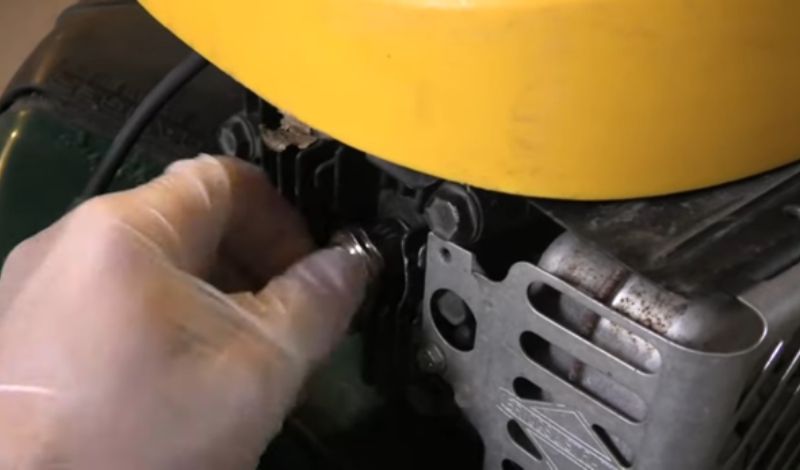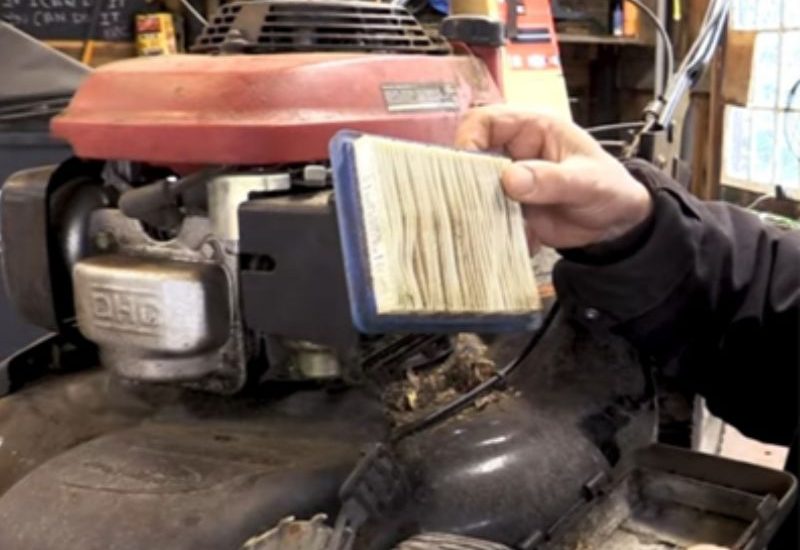Step by Step Onion Planting Guide for Healthy, High-Yield Crops
Planting onions starts with picking the right spot and getting the soil ready. The key to growing onions is loose, well-drained soil and plenty of sunlight. That’s what onions love most.
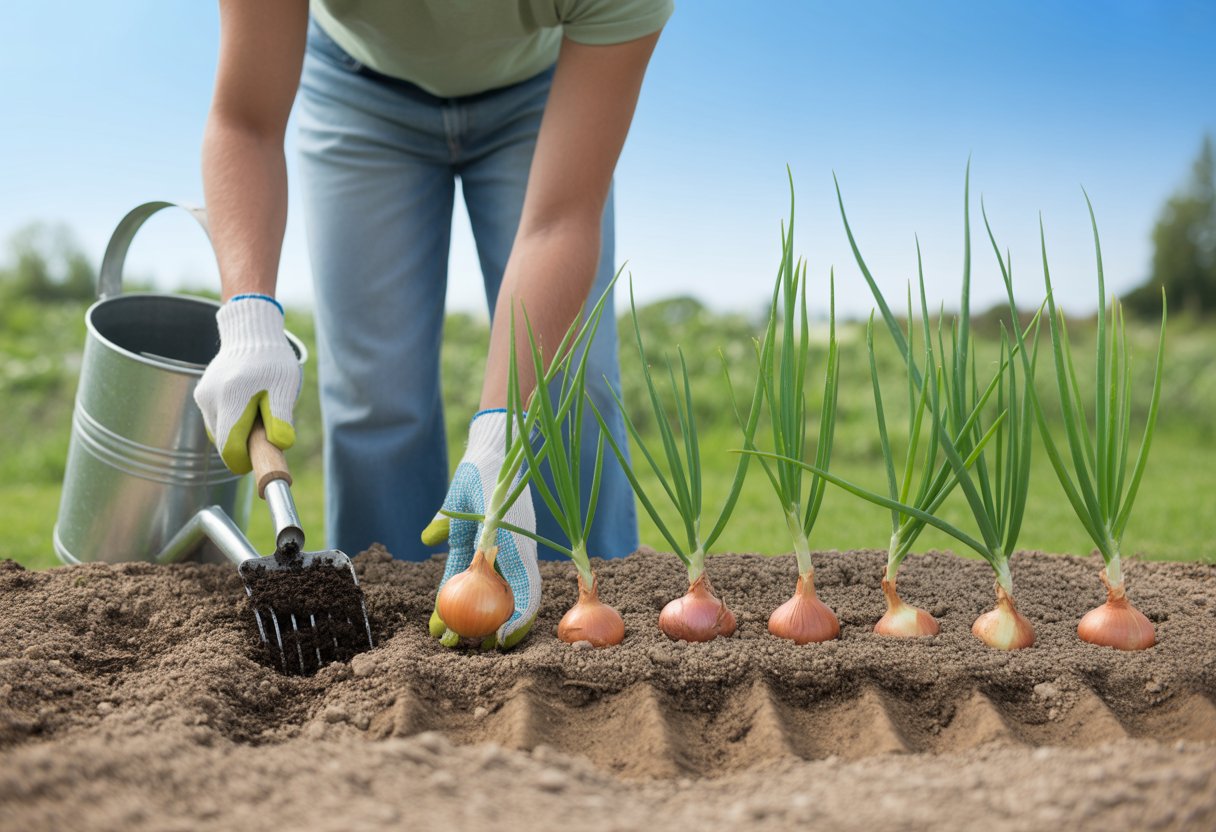
Knowing when and how to plant onion sets, seeds, or transplants makes a huge difference in your harvest. You’ll want to pay attention to spacing and depth to avoid crowding and help those bulbs develop.
Keep the soil moist but not soggy—onions don’t like wet feet. Take things step by step, and you’ll boost your odds for a solid onion crop.
Choosing the Right Onion Varieties
Picking the right onion means thinking about day length, your planting material, and which varieties fit your climate. These choices affect everything from flavor to harvest time.
Understanding Day Length Types
Onions form bulbs based on how much daylight they get. Short-day onions start bulbing at about 10-12 hours of sunlight, so they’re best for southern areas with mild winters.
Long-day onions want 14-16 hours of daylight, thriving up north. Intermediate-day types need 12-14 hours and suit gardeners in between.
If you plant a short-day onion up north, it probably won’t bulb up right. Matching the type to your region is crucial.
Selecting Onion Sets, Seeds, or Transplants
You can start onions from seeds, sets, or transplants. Seeds give you the most variety but need a long season and a patient touch.
Sets are tiny, immature bulbs that get going fast and are great for beginners. They’re less fussy, though you might get fewer choices.
Transplants are young onions started elsewhere and then moved into your garden. They’re a good middle ground. Choose what fits your climate, season, and taste.
Popular Onion Varieties for Home Gardens
Classic onions like yellow, red, and sweet (Allium cepa) all have their fans. Yellow onions are reliable, store well, and often come in long-day or intermediate types.
Red onions, usually long-day, are favorites for salads and grilling because they’re mild and colorful. Sweet onions—think Vidalia or Walla Walla—shine in the right climate and are famously mild.
Want fresh greens? Scallions (green onions) are easy, or you can just pick bulb onions early. Picking varieties that suit your local climate really pays off.
Preparing the Garden for Onion Planting
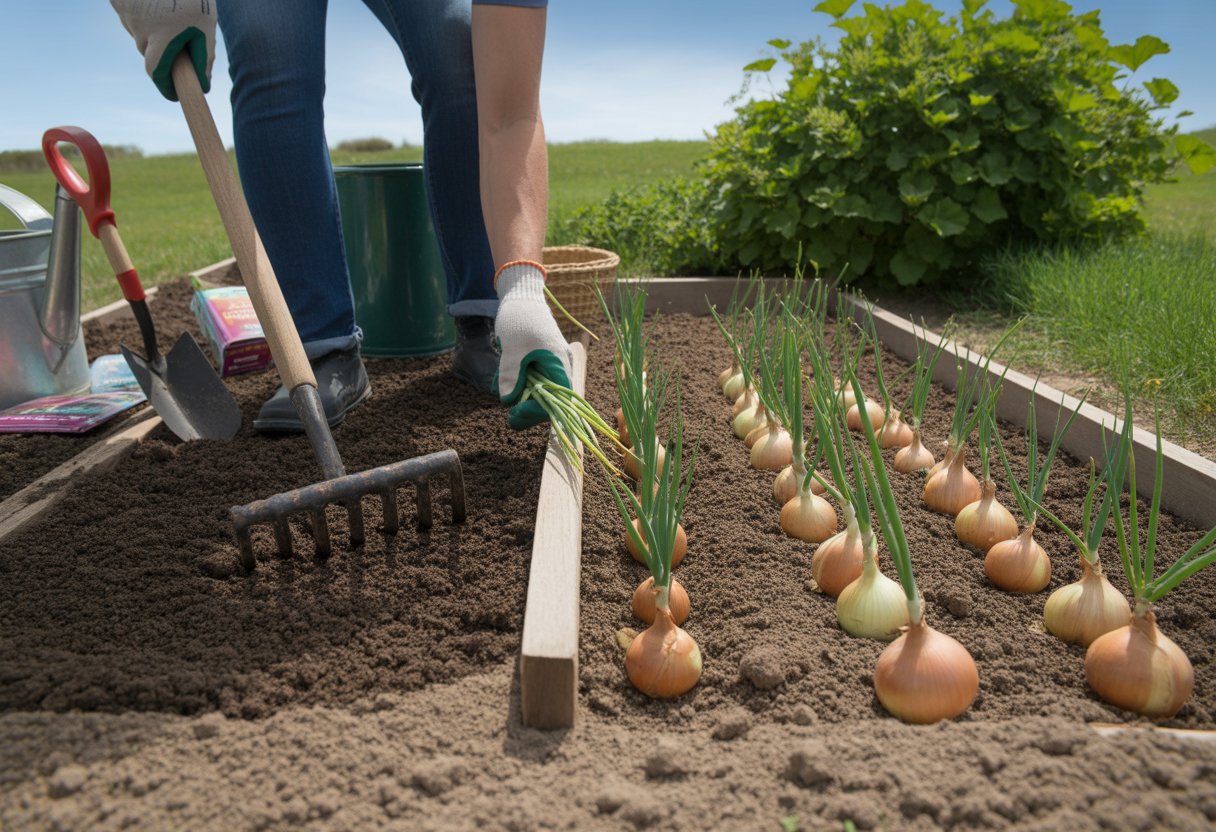
Getting ready means picking a good spot, checking soil quality, and making a few tweaks for better growth. These steps help onions avoid common problems like poor drainage or weak bulbs.
Selecting and Preparing Planting Beds
Onions need well-drained soil to avoid root rot. Raised beds or rows work well, especially if your soil’s heavy. Find a spot that gets at least 6 hours of sunlight a day.
Clear out weeds and debris so onions don’t have to compete. Loosen the soil down 8-10 inches with a fork or tiller, aiming for a crumbly texture. Space beds 12-18 inches apart for airflow and less disease risk.
Soil Requirements and Drainage
Onions do best in loose, fertile soil with good drainage. If your soil holds water or gets compacted, onions will struggle and might rot. Raised beds or mounds help water drain away from roots.
Remove stones and aim for a mix of sand, silt, and clay. Good drainage plus moist—not soggy—soil keeps roots happy. Test your drainage before planting so you know if you need to raise beds or adjust your soil.
Amending Soil and Adjusting pH
Onions like a pH between 6.0 and 7.0. Test your soil to see if you need lime (to raise pH) or sulfur (to lower it). Mix in compost or well-rotted manure to boost fertility and structure.
Use a balanced fertilizer with more phosphorus and potassium, but go easy on the nitrogen. Skip fresh manure—it can burn roots. Work amendments into the top 6-8 inches for even nutrients and better moisture.
Step by Step Onion Planting Process
Planting onions isn’t rocket science, but timing, technique, and spacing matter. Mulching and early weed control help a ton with healthy growth and bulb formation.
When to Plant Onions
Get onions in the ground in early spring, as soon as the soil’s workable. Ideal soil temps are 50°F to 70°F. In colder spots, plant about 4-6 weeks before your last frost.
Sets and transplants can go in early, but seeds might need a bit more warmth. Onions have shallow roots that don’t handle temperature swings well, so early planting gives them a head start.
Planting Techniques for Bulbs, Sets, and Seeds
Plant bulbs and sets with the pointy end up. Bury them so about two-thirds is underground. For seeds, sow them thinly in shallow rows and cover with no more than ¼ inch of soil.
Space transplants carefully to avoid crowding. Water right after planting to settle the soil. Onions don’t mind being shallow—their roots stay near the surface.
Spacing and Depth Guidelines
Spacing matters for bulb size and airflow. Give sets and transplants about 4 inches between plants, with rows 12 inches apart. When seedlings from seed reach 3 inches tall, thin them to 2-4 inches apart.
Plant bulbs and sets 1 to 1.5 inches deep—just enough to cover the base, not the neck. Keep seed rows shallow for quicker sprouting. Stick to these numbers for even growth.
Mulching and Early Weed Control
Mulch after planting to hold moisture and keep weeds down. Straw or shredded leaves work well. Mulch also evens out soil temperature for those shallow roots.
Pull weeds by hand or use a light hoe, but don’t disturb onion roots. Early weed control leaves more nutrients for your onions and can lead to bigger bulbs.
Caring for Onion Plants Until Harvest
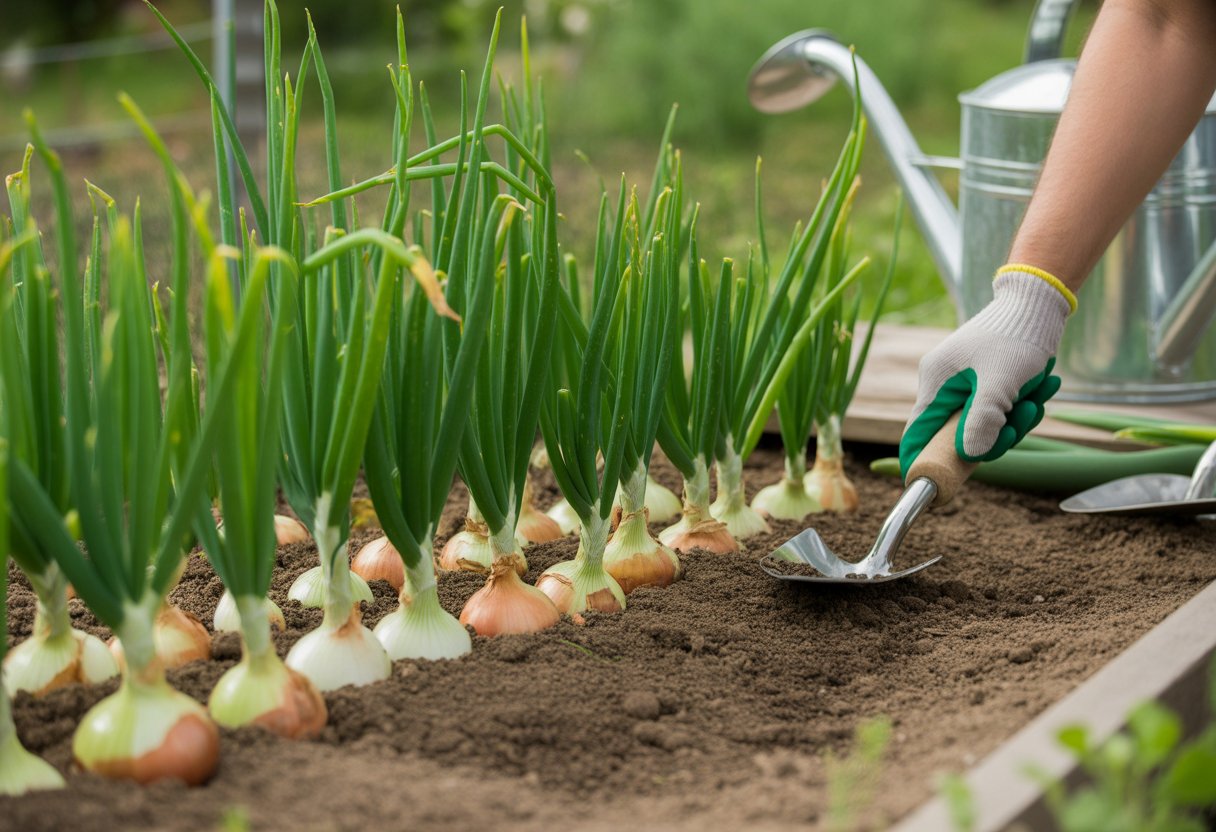
Onions need steady care to form strong bulbs. Feeding, watering, and disease management all play a role. Keep an eye on the soil and know when it’s time to harvest.
Fertilizing and Watering Routine
Onions are pretty hungry plants and need regular feeding. Start with a high-nitrogen fertilizer for leafy growth, then switch to more phosphorus and potassium as bulbs form. Apply fertilizer every 2-3 weeks, following the label.
Water about 1 inch per week, making sure it soaks in evenly. Don’t drown the plants—soggy soil leads to rot. As bulbs mature, cut back on water to help them dry out and avoid disease.
Maintaining Soil Moisture and Weed Control
Keep the soil evenly moist, especially when bulbs are forming. Mulch with straw or grass clippings to lock in moisture and keep the soil cool. Don’t let the soil dry out at this stage.
Weeds steal water and nutrients, so stay on top of them. Hand-pulling works best early, but you can use shallow cultivation if you’re careful not to disturb roots. Clean beds mean healthier onions.
Preventing and Treating Common Onion Diseases
Rotate crops to dodge soil-borne diseases like white rot. Don’t plant onions in the same spot for at least three years.
Good air circulation and avoiding overhead watering help prevent downy mildew and purple blotch. If you spot symptoms, try a fungicide early and pull out infected plants fast.
Blight means you’ll need to remove sick plants and avoid overdoing the nitrogen. Check plants regularly so you can act before problems get out of hand.
Harvesting and Curing Onions
Onions are ready to harvest when the tops turn yellow and flop over. Gently pull up the bulbs—try not to bruise them.
Lay the onions in a single layer. Choose a warm, shaded spot with good airflow, and let them dry out for 2-3 weeks.
Curing helps the onions form a tough skin, which keeps rot at bay. Once they’re cured, trim the roots and tops down to about an inch.
If you store them right—in a cool, dry place—these onions can hang in there for several months.

